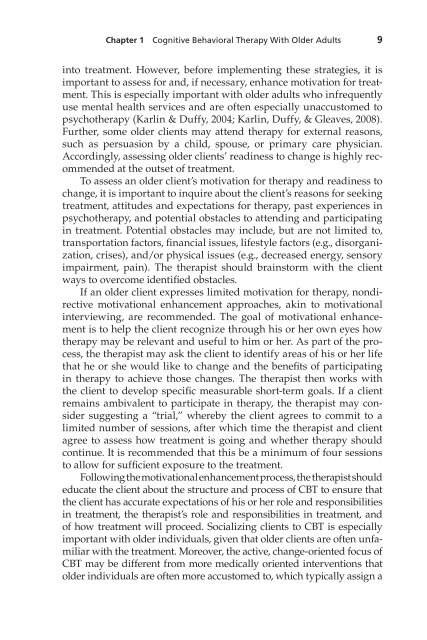Cognitive Behavior Therapy with Older Adults - Springer Publishing
Cognitive Behavior Therapy with Older Adults - Springer Publishing
Cognitive Behavior Therapy with Older Adults - Springer Publishing
You also want an ePaper? Increase the reach of your titles
YUMPU automatically turns print PDFs into web optimized ePapers that Google loves.
Chapter 1 <strong>Cognitive</strong> <strong>Behavior</strong>al <strong>Therapy</strong> With <strong>Older</strong> <strong>Adults</strong> 9<br />
into treatment. However, before implementing these strategies, it is<br />
important to assess for and, if necessary, enhance motivation for treatment.<br />
This is especially important <strong>with</strong> older adults who infrequently<br />
use mental health services and are often especially unaccustomed to<br />
psychotherapy (Karlin & Duffy, 2004; Karlin, Duffy, & Gleaves, 2008).<br />
Further, some older clients may attend therapy for external reasons,<br />
such as persuasion by a child, spouse, or primary care physician.<br />
Accordingly, assessing older clients’ readiness to change is highly recommended<br />
at the outset of treatment.<br />
To assess an older client’s motivation for therapy and readiness to<br />
change, it is important to inquire about the client’s reasons for seeking<br />
treatment, attitudes and expectations for therapy, past experiences in<br />
psychotherapy, and potential obstacles to attending and participating<br />
in treatment. Potential obstacles may include, but are not limited to,<br />
transportation factors, financial issues, lifestyle factors (e.g., disorganization,<br />
crises), and/or physical issues (e.g., decreased energy, sensory<br />
impairment, pain). The therapist should brainstorm <strong>with</strong> the client<br />
ways to overcome identified obstacles.<br />
If an older client expresses limited motivation for therapy, nondirective<br />
motivational enhancement approaches, akin to motivational<br />
interviewing, are recommended. The goal of motivational enhancement<br />
is to help the client recognize through his or her own eyes how<br />
therapy may be relevant and useful to him or her. As part of the process,<br />
the therapist may ask the client to identify areas of his or her life<br />
that he or she would like to change and the benefits of participating<br />
in therapy to achieve those changes. The therapist then works <strong>with</strong><br />
the client to develop specific measurable short-term goals. If a client<br />
remains ambivalent to participate in therapy, the therapist may consider<br />
suggesting a “trial,” whereby the client agrees to commit to a<br />
limited number of sessions, after which time the therapist and client<br />
agree to assess how treatment is going and whether therapy should<br />
continue. It is recommended that this be a minimum of four sessions<br />
to allow for sufficient exposure to the treatment.<br />
Following the motivational enhancement process, the therapist should<br />
educate the client about the structure and process of CBT to ensure that<br />
the client has accurate expectations of his or her role and responsibilities<br />
in treatment, the therapist’s role and responsibilities in treatment, and<br />
of how treatment will proceed. Socializing clients to CBT is especially<br />
important <strong>with</strong> older individuals, given that older clients are often unfamiliar<br />
<strong>with</strong> the treatment. Moreover, the active, change-oriented focus of<br />
CBT may be different from more medically oriented interventions that<br />
older individuals are often more accustomed to, which typically assign a

















